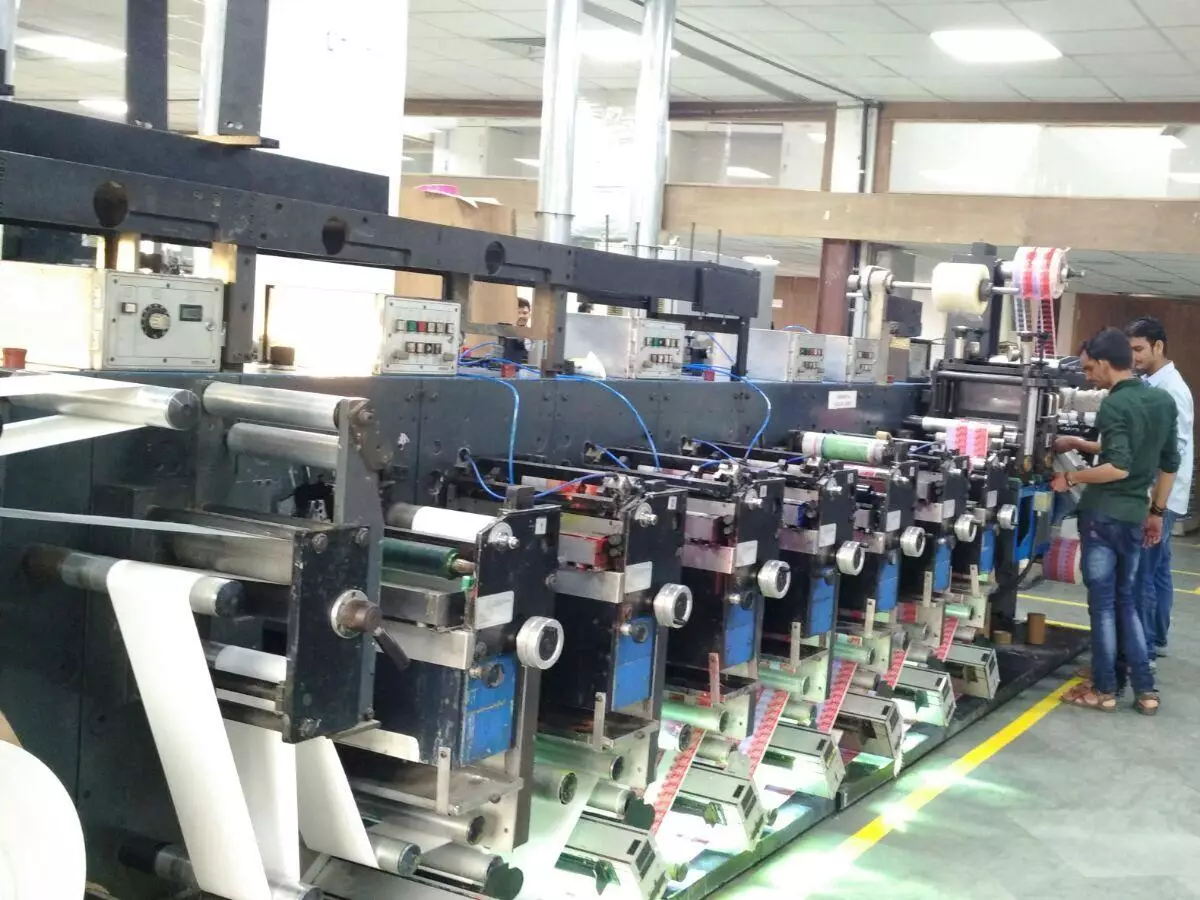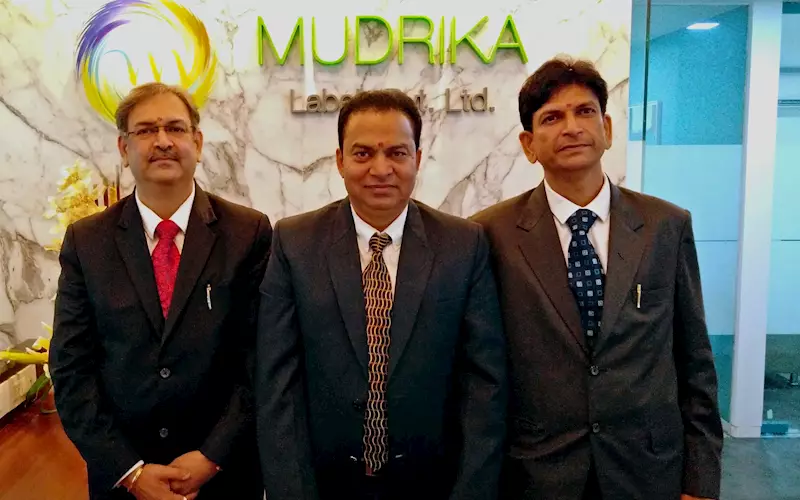It wasn’t surprising to hear about Mudrika Labels’ development of Fresnel lens label on pre-registered holographic film. After all, the company has been one of the leading label manufacturers in the industry, adding machines and capacity, introducing new types of labels and stitching up joint ventures for producing labels using different methods.
Indeed, Mudrika Labels exemplifies what can happen to a small, family-founded business under the tutelage of three Desai brothers, Sandip, Manish and Vipul, all three sparing no expense to gain dominance in the packaging business ranging from self-adhesive to IML to heat-transfer films and decals.
On 7 March 2016, Mudrika Labels formally inaugurated its new plant in Vasai, 50kms off Mumbai, a 50,000 sq/ft site, equipped with 11 flexo machines, six of which are Gallus’ including the newest ECS-340, a Dae Heung Machinery gravure press, and a raft of finishing equipment.
Gallus' Mr and Mrs Ruesch inaugurating the new Mudrika facility
The beginning
The Desai brothers began their labels business way back in 1976 with a screen printing facility. Besides Mudrika Labels, which the brothers established in 1996 in Mumbai, they own operate an offset-based corrugation unit in Daman and Bhillad; a packaging plant in Vasai; a label-stock material plant; and a joint venture with a South Korean partner for manufacturing heat transfer films, decals and in-mould labels.
Sandip, the eldest of the three brothers manages the corrugation and packaging business, Vipul, an environmental engineer, the youngest, is in charge of the offset business and also the label stock manufacturing, while Manish helms Mudrika Labels.
In 2006, Mudrika also moved to Vasai but operated from two different units, one for flexo and the other for gravure. In search of new label business, the Desai brothers joined hands with a South Korean partner in 2012 and started the manufacture of heat transfer films, decals and in-mould labels.
“In 2015, we started the process of consolidating our scattered units of narrow-web and gravure printing under one roof. With the newly inaugurated plant it has brought all the label businesses under one roof,” says Manish.
Mudrika today has an installed capacity of 50,000 sq/metres per day, a combined space of over 1-lakh sq/ft and employee strength of 350+.
The growth and innovation play
It’s one thing to expand, and another to make success in the face of rising competition. How does Mudrika manage that?
“There are two kinds of competition we are facing today. One is price war; the second comes from multi-location plants. We manage price by buying bulk where we get good discounts on every material we buy and also utilising the label stock we manufacture,” says Manish.
Yet, in a segment like labels, where firms compete feverishly on price chomping away their margins, the growth and innovation that Mudrika is achieving is what we like. Why? Because, through investment in infrastructure and machinery, Mudrika brings advanced printing technology to the playing field by which it can offer on-time delivery and services that its customers require. And by taking the route of honing its services through differentiation, the company has put itself in a position of gaining compelling yield.
For example, take the development of Fresnel lens label on pre-registered holographic film. It has been a prestigious project for the company. And it’s been about a year or so that the tests and re-tests are being worked out.
But there is no worry. Mudrika’s fortitude and ability to deal with such tasks assured that not too much fuss has been raised until the project is completed, and which it almost has.
Mudrika will perhaps become only the second label printer in the world to achieve the Fresnel lens effect by printing on a pre-registered holographic film on a flexo press. “The client has been procuring the lens labels from China and wanted us to develop such labels locally. The technology was not readily available with us. We said, spare a couple of product launches and we will work on the technology and then take up the work,” says Manish Desai, one of the three brothers at the helm in Mudrika.
In late 2015, Mudrika installed its sixth Gallus press, the ECS 340 and with it started the experiment of producing lens label. The task was to print on top of the holographic lens substrate in a tight register to achieve a life-like perspective that produces the impression of depth and provides the label with a tactile quality.
Now, the catch is that the holographic lens roll vendors do not promise constant repeats (distance between two lenses on the roll) across the length of the rolls. This is due to the technological limitations of the holographic lens making process. “How do you achieve a tight register when your input rolls do not have constant repeats?” asks Desai.
Without disclosing how he does it, Desai says, we put to use the insetting technology of Gallus which allowed accurate registration on the label roll with the lens. The ability to use insetting to run the web through the press and print it several times is particularly interesting. How Mudrika has developed this insetting concept to suit its requirements is the trick up its sleeve. “It has more to do with the software than with anything else,” says Desai with a grin on his face.
The company uses its own pre-press expertise and a printing kit, details of which Desai did not divulge, to create the pre-printed lens label, after which it is printed on the ECS 340. “We received great support from Gallus, whose engineers simulated the environment under which the lens labels were printed, and ran the test,” says Desai.
But what’s so great about producing something that is already being done in China? Desai agrees, but says, “We did not get the technology from China; we developed it by spending lakhs on just the lens label stock. But the important part is that we have been able to produce it at a cost, which is lower than the printer in China. And that will be our USP.” That’s like doing a China on China.
The client, for whom Mudrika has done this project, now wants it to supply the labels for this particular product world over.
With this Mudrika has devised its own solution, and Desai says, these experiments his company does creates new niche areas for the company.
Other successes
Mudrika’s sister concern, Multivision Packaging established in 2006 is also expanding. Next month, Multivision will bring in its sixth Heidelberg press, this time, a six-colour plus coater. This company is engaged in Mono-carton business.
Interpack, with semi-automated corrugated plants, specialises in master cartons, shippers and e-fluted multi-coloured boxes having an annual capacity of 6,000 metric tonnes.
V-Tech Packaging, its label-stock manufacturing unit is also located in Vasai. It has four water-based coaters and a hotmelt slot die-coaters with an installed capacity of 45,000 sq/metres per day. “We produce specific label stock materials for specialised adhesive and films,” says Vipul.
In all the above successes, strengthening infrastructure with machines from time to time is the common thread.
Mudrika got its first Gallus in 2005, an EM 280, the next EM 280s in 2008, 2012, 2014 and in 2015 it installed two Gallus’ – an EM 280 and the ECS 340. “See I got the ECS because I had to do the lens label job,” says Manish. “It is with this kind of innovative jobs with which our customers grow and with them we too grow.”
The other way Mudrika is growing its business is by getting their existing customer to move from cut-sheet labels to self-adhesive labels. “We showed our clients the advantages of self-adhesive labels, and were able to convert around eight customers to using self-adhesive labels,” says Manish.
Positives for label segment
Manish says, the fact that only 3% of the packaging pie is labels and the fact that the per capita consumption of labels is still pegged at 0.30 sq/ft, reflect the growth potential for this segment . “It is a small market because at the moment application of labels is limited. But I think for a country of India’s size, the potential for application of labels is huge.”
However, talk of digital printing in labels, and Manish says he does not see the technology make a dent in labels segment, at least not in India for some time. “Worldwide the demand for labels is going down, because of which short-run SKUs are going up. It makes more sense for the printers in those countries to go digital. But in India, we still produce labels in big numbers, and flexo makes more sense to us.”
Manish says that he does not see digital as an option for Mudrika either, not in the next two-three years. But he says customisation is a very important marketing tool, sought for by the marketing clients, not the production clients. “We do some value-addition as per the customer demand. But in future if my customer demands jobs which need the intervention of a digital press, we will opt for it,” he says.
Manish says, our argument is simple. Investment in machinery is part and parcel of a healthy industry. While installation numbers will show general market trends, using them in a given market requires certain calculations. “I would say, it always helps to find out the factors that are driving the latest trend and try to determine whether it is shaping up to benefit your operations or not,” says Manish.
Through 2015, the Desai brothers as a group have focused on expansion keeping abreast with changing trends and latest technology. With the developments in lens labels showing positive signs, Mudrika is on a path of boosting its reputation in the label innovation worldwide.
And as a jewel in India’s label crown, it looks forward to further experimentations and innovations, which will take Mudrika to a higher echelon in the Indian label industry. “We want to make Mudrika the top most label company in India,” conclude the Desai brothers.
















 See All
See All